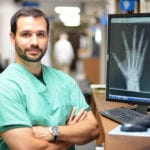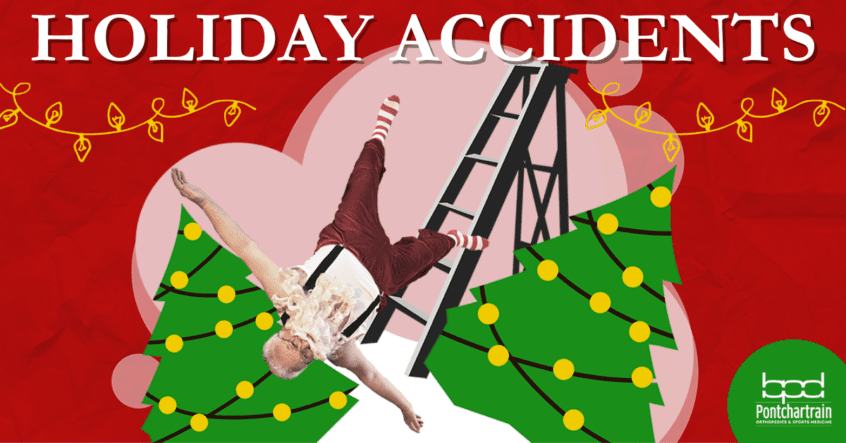
It’s time to string the lights and decorate that tree! The holidays bring a lot of joy to our homes, but one bad fall off a ladder can really take the sweetness out of your eggnog. Thankfully, today’s post includes some of Santa’s ladder safety tips to avoid holiday hand injuries (and some helpful insights from our own Dr. Donnelly).
Common holiday injuries include lacerations from scissors while wrapping gifts or picking up broken ornament pieces, pine needles poking people in the eyes, back strains or sprains from lifting Christmas trees and heavy boxes, and most of all, hand, wrist, and elbow injuries from falling from roofs or falling off of ladders while decorating.
Around 160 injuries related to holiday decorating every day during the holidays in the United States.
The Consumer Product Safety Commission reports around 160 injuries related to holiday decorating every day during the holidays in the United States. Nearly 50% of these incidents result from falls, often causing fractures, concussions, and muscle strains. Each hand has more than 120 ligaments, 27 bones, 29 joints, and an extensive network of nerves. As you might guess, many of the injuries are sustained after falling from ladders while decorating your tree or home, and the majority of these types of injuries are a result of FOOSH.
What the FOOSH!?
FOOSH, an acronym for "falling on outstretched hand," occurs when the instinctive response to a fall is extending your hands to catch yourself. This can lead to various injuries, including distal radial or elbow fractures, dislocations, and ligamentous damage in the wrist, elbow, or shoulder. The impact travels through the hand, arm, and shoulder during the fall, often causing sprains or fractures.
The Most Common FOOSH-related Injuries Are:
- Wrist, Elbow, or Forearm Fractures: Can occur as a result of impact and often from extended hand landings during falls.
- Wrist Ligament Injuries: Can occur when the wrist is twisted or subjected to a fall.
- Distal Radius Fractures: Of the two forearm bones (ulna and radius), the radius is most commonly broken. When it’s broken on its distal end (near the wrist), the fracture is called a distal radius fracture.
- Scaphoid Fractures: Caused by wrist hyperextension, placing stress on the scaphoid bone.
- Nighttime Symptoms: CTS symptoms frequently intensify at night. Many individuals wake up with pain, tingling, or numbness in their hands, prompting them to shake or massage their hands for relief.
How to Avoid FOOSH Injuries during the Holidays:
- Only use well maintained ladders or step stools.
- Do not use ladders that are wet or icy.
- If using a ladder near a doorway, lock the door and/or post signs on the door to prevent others from opening it and knocking you off the ladder.
- Always keep one hand on the ladder to secure yourself.
- Be sure the area around you is well lit when using a ladder.
What to do if you’ve been injured from a fall:
About Dr. Brandon P. Donnelly, MD
 Dr. Brandon P. Donnelly is a board certified hand surgeon with Pontchartrain Orthopedics & Sports Medicine. Dr. Donnelly completed his hand and microsurgery fellowship at the prestigious Philadelphia Hand to Shoulder Center. Dr. Donnelly treats all ages of patients in the greater New Orleans area for hand, wrist, and elbow conditions.
Dr. Brandon P. Donnelly is a board certified hand surgeon with Pontchartrain Orthopedics & Sports Medicine. Dr. Donnelly completed his hand and microsurgery fellowship at the prestigious Philadelphia Hand to Shoulder Center. Dr. Donnelly treats all ages of patients in the greater New Orleans area for hand, wrist, and elbow conditions.
This site is not intended to and does not provide medical advice, professional diagnosis, opinion, treatment or services to you or to any other individual. Through this website and links to other websites, Brandon P. Donnelly, MD provides general information for educational purposes only. The content provided in this website and links, is not a substitute for medical care or treatment. You should not use this information in place of a consultation or the advice of your healthcare provider. Brandon P. Donnelly, MD is not liable or responsible for any advice, course of treatment, diagnosis or any other information, services or product you obtain through this site.

